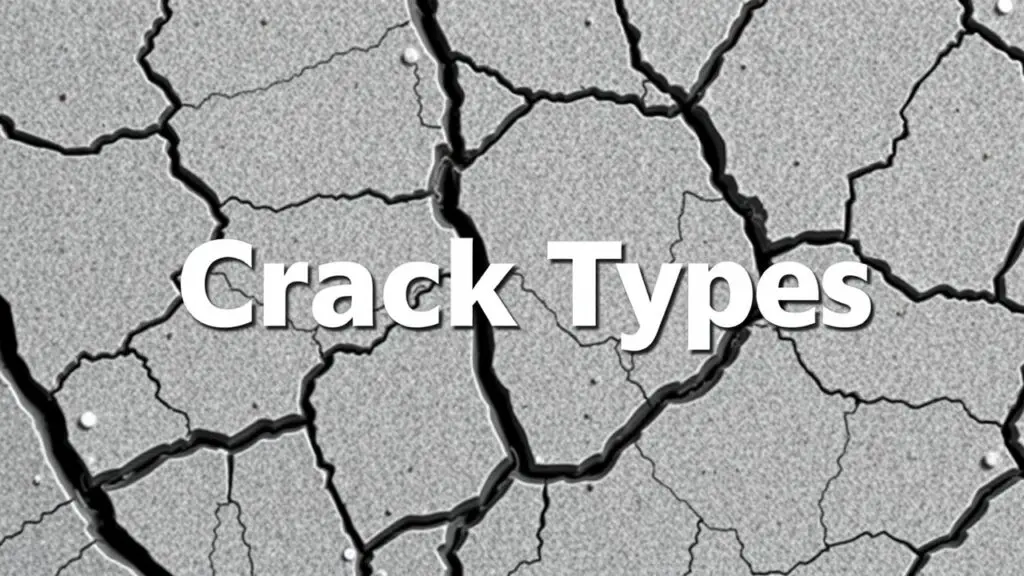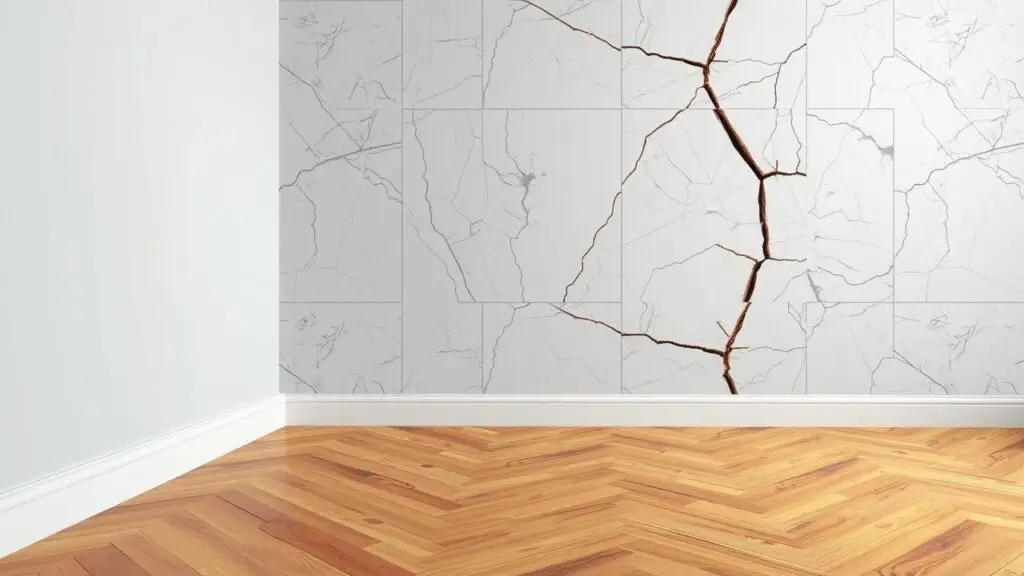Types of cracks in brick walls, concrete, and other materials vary widely. This guide helps identify different crack types, understand their causes (like foundation settling), and learn effective repair methods.
What Are Cracks?

Cracks are breaks or gaps that can form in different materials. They can really hurt the strength of structures and make them look bad. You can find cracks in concrete, plaster, brick, asphalt, and wood. Each material cracks in its own way.
- Concrete Cracks: These often happen because of shrinkage during curing or due to outside factors like temperature changes.
- Plaster Cracks: These usually occur when a building settles or due to moisture problems.
- Brick Cracks: Brick can crack from foundation movement or thermal expansion.
- Asphalt Cracks: You often see these in driveways and roads because of weather and heavy traffic.
- Wood Cracking: Wood may crack as it dries out or when humidity changes.
By knowing about these cracks, homeowners can spot issues that might affect their safety and how their property looks.
Why Identifying Crack Types Matters?
Knowing the type of crack is key for safety and finding the right repair method. If a crack is misidentified, it might lead to repairs that don’t fix the problem or even make it worse. For example:
- Hairline vs. Settlement Cracks: Hairline cracks are often small and not serious, while settlement cracks could mean there are major foundation issues that need quick fixing.
If you ignore the proper assessment, you could face serious risks like structural damage or safety problems at home. Homeowners should learn about different foundation cracks—like settlement cracks caused by soil shifting versus shrinkage cracks from drying—and know what they mean for overall stability. Proper identification helps ensure timely actions that keep both the building’s integrity and residents safe.
Common Types of Cracks Explained
Hairline Cracks
Hairline cracks are thin lines that show up in drywall or concrete. These cosmetic cracks come from thermal expansion and contraction, or from shrinkage as the material dries. At first, they might seem serious, but they usually don’t mean there’s a big problem. If these cracks start to grow or multiply, it could point to something that needs looking into.
Map Cracks
Map cracking looks like a network of lines on the surface of concrete. This happens often because of uneven soil movement below the foundation caused by moisture changes. It’s important to watch map cracks closely since they can indicate problems with your foundation.
Shrinkage Cracks
Shrinkage cracks happen when new concrete dries too fast and loses moisture quickly. If the mixing ratios are off or the weather is dry, this can cause issues. These cracks are usually small, but over time they might weaken your structure if ignored. Using sealing techniques can help keep water out and improve strength.
Settlement Cracks
Settlement cracks form when a building’s foundation settles unevenly. This could be due to soil compaction or other stability issues. If you see these types of cracks, it’s wise to take them seriously since they can lead to bigger structural problems down the road. Getting a professional assessment is a smart move for figuring out how serious it is and what repairs are needed.
Stress Cracks
Stress cracks appear in areas that carry heavy loads like beams and columns. They may also form due to quick temperature changes that make materials expand and contract differently. To fix stress-related damages, it often helps to add extra support in those affected areas.
Fatigue Cracks
Fatigue cracks result from repeated stress on materials over time, which weakens them. Ignoring these can lead to major failures, especially in important structures like bridges that handle heavy loads regularly. Regular checks can help spot fatigue cracks early so repairs can be made before things get worse.
Understanding these common types of cracks can help homeowners catch issues early on and find effective ways to repair them based on each situation’s needs.
Crack Types by Material: A Deeper Dive
Cracks in Concrete
Concrete is tough but can crack. Knowing the types of cracks helps you figure out how serious they are and how to fix them.
Specific Types
- Plastic Shrinkage Cracks: These happen when fresh concrete dries too fast.
- Heaving Cracks: Soil beneath the slab expands or frost causes it to rise, creating cracks.
- Settlement Cracks: As the ground settles, diagonal lines may appear on walls or floors.
Causes
Common causes include rapid moisture loss due to heat or wind, not curing properly, and temperature changes that make concrete expand and contract.
Repair Methods
Fixing concrete cracks varies by type:
- For small hairline cracks, use epoxy filler.
- Bigger settlement or heaving cracks might need injecting polyurethane foam or patching compounds for stability.
Cracks in Brick Walls
Brick walls are strong but can crack too. The type of crack can show if there’s a problem with the foundation.
Specific Types
- Diagonal Cracks: Found at corners of windows and doors, indicating movement.
- Stair Step Cracks: Seen along mortar joints; these suggest settling issues in the foundation.
Causes
Brick wall cracking usually comes from foundation movement due to soil pressure changes or poor drainage around the building.
Repair Methods
To fix brick wall cracks:
- Fill small vertical and horizontal cracks with masonry caulk.
- For larger damage, replace bricks or repoint mortar joints for strength.
Cracks in Plaster and Stucco
Plaster adds beauty to walls but may crack over time, showing patterns that need fixing.
Specific Types
Common patterns include small spider web-like fissures for minor stress and larger gaps that indicate serious issues like shifting foundations.
Causes
Cracking often results from thermal stress due to temperature changes combined with moisture entering the materials.
Repair Methods
For repairs:
- Use joint compound for minor plaster cracks, then sand smooth when dry.
- Remove damaged sections for larger areas before applying new plaster layers for a better look.
Cracks in Wood
Wood structures can crack due to environmental factors if not cared for properly.
Specific Types
Splits can form from drying out during low humidity or absorbing too much moisture causing swelling followed by shrinkage.
Causes
High humidity lets wood absorb water, while dry air makes it lose water quickly. Both lead to splits over time.
Cracks in Asphalt
Asphalt surfaces face problems that lead to cracking based on use and wear over time.
Specific Types
Surface-level failures are often from fatigue caused by heavy traffic loads. Deeper structural failures usually come from freeze-thaw cycles hurting the base beneath asphalt layers.
By knowing about these different kinds of cracks—whether in concrete, brick walls, plaster finishes, wooden beams, or asphalt pavements—you’ll have a better idea of what needs attention and how to take care of it!
Assessing Crack Severity: Visual Inspection and Advanced Techniques
Keeping an eye on cracks in your home is important for safety. Whether you’re a homeowner or a contractor, knowing how to look for and assess cracks can help prevent bigger problems down the road.
Visual Inspection: Key Factors
When checking for cracks, think about these factors:
- Width of the crack: A hairline fracture is usually less serious than a wider gap, which could mean trouble.
- Length of the crack: Longer cracks often signal more severe issues below the surface.
- Pattern: Diagonal or horizontal cracks can indicate different problems than vertical ones. For instance, diagonal cracks might mean the building is settling.
- Location: Where the crack is matters; foundation cracks inside your home are especially concerning.
- Material affected: Brick walls and concrete surfaces may show different types of cracking.
These points help you identify potential risks from different kinds of cracks.
Crack Width Measurement: Tools and Techniques
Getting accurate measurements is key when assessing crack severity. Here are some tools you can use:
- Use calipers to measure both width and depth accurately.
- Specialized tools like crack gauges can help track changes over time, showing if any damage is getting worse.
These methods give you reliable data on any visible damage.
Advanced Diagnostic Techniques
If you want to go beyond just looking at cracks, consider these advanced techniques:
- Ultrasonic testing uses sound waves to check internal conditions without harming materials around it.
- Ground penetrating radar (GPR) helps spot subsurface problems that might cause cracking by sending radar pulses into the ground and analyzing what bounces back.
These non-destructive methods provide useful insights into hidden issues that could affect your structure’s safety.
When to Call a Professional
Some signs mean it’s time to call in an expert due to serious concerns about structural integrity:
- Large or deep fractures in load-bearing areas need quick attention since they can pose major risks.
- Look out for signs like bowing walls or sagging foundations; these often indicate significant structural issues.
- If small problems seem to be growing into larger ones, it’s smart to consult a pro before things get worse.
Noticing these signs early can save you money on repairs later and help keep your home safe.
Crack Repair Methods: A Practical Guide
Repair Methods for Minor Cracks
Minor cracks, like hairline and drywall cracks, are usually just cosmetic issues. But they can be fixed easily. Here’s how to tackle them effectively.
Filling: To fix minor cracks in plaster and drywall, use the right fillers. For plaster walls, lightweight spackling compound works great because it dries fast and is easy to sand down. If you’re dealing with drywall, try joint compound or pre-mixed patching compounds made just for that. These options help create a smooth finish ready for paint.
Caulking: Caulk is perfect for filling small gaps around windows, doors, or between different materials that might move. Use an interior caulk for inside jobs and exterior-grade caulk for outside to resist weather changes. Silicone-based caulks are flexible and hold up well against moisture, while acrylic latex caulks are easier to paint over.
Patching: Patching techniques can enhance the look of surfaces without affecting their strength. For larger drywall cracks, cut out the damaged part into a square. Then, fit in a new piece of drywall, using joint tape and compound to cover the seams once it’s installed.
Repair Methods for Moderate Cracks
Moderate cracks need a bit more attention as they could mean bigger problems related to settling or shifting foundations.
Injection Techniques: Epoxy or polyurethane injections are solid methods for filling voids in concrete caused by moderate cracking. The process involves drilling holes into the crack area where these materials are injected under pressure until all gaps in the concrete slab or wall fill up completely.
Sealing Cracks: It’s important to choose the right sealants based on the material type—like asphalt versus concrete—to ensure lasting results after sealing moderate cracks. Clean out debris from the crack first before applying your chosen sealant with either a putty knife or special applicator tool.
Repair Methods for Severe Cracks
Severe cracks can threaten structural integrity and need immediate attention from professionals when necessary.
Structural Reinforcement: Severe cracking in load-bearing walls may need steel braces or carbon fiber strips for support during repairs. This helps stabilize weakened structures and stops further damage from stress on those areas.
Foundation Repair Solutions: Fixing foundation issues takes careful assessment by professionals who might suggest solutions like underpinning, which adds support beneath existing foundations based on how much soil movement occurs at the site.
Choosing the Right Repair Material
Picking the right repair materials is key to effective restoration based on each unique crack situation encountered.
When comparing different types of sealants available today—like silicone-based versus acrylic—also consider how well they’ll work with existing materials (e.g., wood vs concrete). This guarantees strong adhesion along treated surfaces and helps achieve desired outcomes!
Preventing Cracks: Best Practices for Different Materials

Prevention Strategies for Concrete
To stop cracks in concrete, it’s super important to cure it properly. Curing helps the concrete get strong and cuts down the risk of plastic shrinkage cracks. These cracks happen when the surface dries too fast. You can keep moisture in by using wet coverings or special curing compounds.
Expansion joints also play a big role. They allow movement when temperatures change, which helps avoid stress that could cause cracks. Mixing concrete with the right water-to-cement ratio is key to preventing problems like reinforcement corrosion cracks from too much moisture.
It’s also important to keep an eye on moisture content during mixing and pouring. By following these strategies, you can greatly reduce the chance of different types of cracks appearing in concrete structures.
Prevention Strategies for Brick
Brick walls can develop vertical or horizontal cracks if not built or maintained properly. To prevent brick cracks, use the right mortar mix suited for your climate and load needs. A strong foundation is a must; it should support the weight of brickwork without settling unevenly.
Regular inspections are smart. Catching early signs of cracks can save you money and hassle later. If you see tiny hairline fractures, address them right away.
Prevention Strategies for Plaster/Stucco
Plaster and stucco can crack if they aren’t applied correctly or looked after over time. Moisture control is really important because too much dampness can weaken plaster bonds and lead to visible cracks.
Using proper application techniques, like applying multiple thin coats instead of one thick layer, will make it stronger and help reduce stress points where cracks might form.
Adding flexible materials to plaster mixes can help resist cracking from thermal changes over time.
Prevention Strategies for Wood
Wood needs attention to prevent cracking due to environmental factors. Using the right fasteners helps keep things stable while allowing wood to move naturally as humidity changes.
Moisture control is very important too; keeping humidity levels steady inside prevents wood from warping or splitting during dry months—something many DIYers forget when working with wood materials.
Prevention Strategies for Asphalt
For asphalt pavements, regular maintenance like sealing every few years protects against wear from traffic and weather exposure. Rainwater can seep through tiny cracks, causing damage underneath if not taken care of.
Good drainage systems around asphalt surfaces can help avoid water pooling, which leads to quicker deterioration and costly repairs later on!
Cost Considerations for Crack Repair
Cost Factors
The type of crack greatly affects repair costs. For example, fixing hairline cracks usually costs less than dealing with severe settlement or fatigue cracks. These bigger cracks may require more work and materials, making them pricier.
The material matters too. Repairs can differ between concrete and brick. Each material needs its own techniques and supplies, which can change the price quite a bit.
Next, consider the location of the crack. If it’s easy to get to, repairs will often be cheaper. But if it’s in a hard-to-reach spot, expect higher costs due to special equipment or more labor.
Evaluating the extent of damage is key. Serious issues might mean you need to fix more than just the crack. For instance, if there’s a foundation problem along with surface cracking, the costs could skyrocket.
Finally, don’t forget about labor costs. Hiring professionals can vary a lot depending on where you live and how complex the job is. It’s smart to get multiple quotes before starting repairs.
DIY vs. Professional Repair
When deciding between DIY repairs and hiring pros, think about the costs and risks involved with each option. While DIY might look cheaper at first glance, it can lead to problems if you’re dealing with big issues like structural damage.
In many situations, it’s better to call in experts rather than risk making things worse on your own. Bad DIY fixes can lead to further damage that costs even more to repair later on.
Keep in mind that bad attempts at DIY may bring hidden costs that could bite you later—making careful consideration crucial for homeowners when figuring out how to fix cracks.
Budgeting for Repairs
Planning a budget for crack repairs means looking at all the factors we discussed earlier like type of crack and extent of damage alongside materials and labor needs.
It’s wise to set aside money not just for immediate repairs but also for preventive measures that help avoid future cracks. This could include improving drainage or scheduling regular inspections to keep your home in good shape without unexpected bills popping up down the road.
Insurance Coverage Implications
Homeowners should understand their insurance coverage concerning damages caused by different types of cracks over time. Each policy differs in what it covers related to home damages, so reviewing your policy can clarify what protection you have against structural issues from normal wear and tear.
Also, make sure to document any existing conditions before starting major work. This helps if you need to file a claim later on regarding pre-existing problems versus new damages after repairs are done—keeping things clear during stressful situations involving home maintenance decisions!
FAQs about Types of Cracks
What are the most common types of foundation cracks?
Common types include vertical, horizontal, and diagonal cracks. Vertical cracks often occur from settling, while horizontal cracks may suggest soil pressure issues. Diagonal cracks can indicate uneven settling or foundation movement.
How can I identify the severity of a crack?
Examine the crack’s width, length, and location. Wider and longer cracks often indicate serious issues. Look for patterns too; diagonal cracks might signal structural problems.
What causes concrete cracks?
Concrete cracks arise from various factors, including shrinkage during curing, freeze-thaw cycles, and poor drainage. Overloading or thermal stress can also lead to cracking.
How are different types of cracks repaired?
Repair methods vary by crack type. Hairline cracks often require sealing with caulk or filler. Severe settlement or structural cracks may need professional intervention and reinforcement.
What are the dangers of ignoring wall cracks?
Ignoring wall cracks can lead to significant structural damage. This could compromise safety and result in costly repairs down the line.
Additional Insights on Crack Types
- Crack Width Measurement: Accurate measurement helps assess severity. Use calipers or gauges for precision.
- Foundation Movement: Regular inspections identify foundation movement early. This prevents larger issues later.
- Preventative Maintenance: Routine checks can spot minor problems before they escalate into serious repairs.
- Concrete Curing: Proper curing techniques reduce the risk of plastic shrinkage and other concrete-related issues.
- Identifying Structural Cracks: Understanding signs of structural damage is crucial for safety and property value.
- Types of Concrete Cracks: Various types include shrinkage, thermal, and plastic settlement cracks; each has unique causes and solutions.
- Repairing Foundation Cracks: Professional assessments are vital for severe foundation issues. These may involve underpinning or other complex methods.
- Signs of Foundation Problems: Look for bowing walls, sagging floors, or exterior wall cracks as key indicators of foundation issues.
- Cost Considerations for Repairs: Costs depend on crack severity, location, and material involved in the repair process.
- Insurance Coverage Implications: Review insurance policies to understand coverage related to structural damage from various crack types.
By addressing these aspects, homeowners can effectively manage different types of cracks in their properties and maintain structural integrity.
Related Topics
- Types of concrete cracks
- Types of brick cracks
- Types of plaster cracks
- Types of wood cracks
- Types of asphalt cracks
- Types of foundation cracks
- Types of crack repair methods
- Types of crack repair materials
- Types of foundation repair solutions
- Types of sealant
- Types of insurance coverage for cracks



Types of Cracks: Identification, Causes & Repair